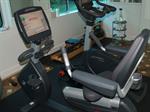
Study, Learn and Work in Human Health and Fitness Management
- Training for
- Health, Fitness or Leisure Centre Support Staff
- Life Coaches, Personal Trainers, Coaches, Consultants
- Marketing, Sales, Product Representatives/Staff
- Writers, broadcasters, editors, publishers.
- Event organisers or managers
- Business owners, Project Managers, or anyone else supplying products or services to these industries
- Open Learning Course -flexible, self paced
- Lots of options to specialize
- Start with a single module if you prefer, then transfer into this study program after you are sure this is where you want to study
- Opportunity for personal mentoring from international experts based in both Australia and the UK -providing a unique international flavour to your education
Course Duration:
- 1500 hours
- Most students spread this over between 3 and 5 years; but some fast track studies and complete it faster, while others take longer.
- Take a break whenever you need it for a few weeks, or a few months. We are very flexible, and keen to provide an education that fits with the student's other commitments
Course Content and Structure
Compulsory Modules
- Fitness Leaders Certificate
- Life Coaching
- Starting a Small Business
- Event Management
- Leisure Facility Management I
- Bookkeeping I
- Workshop I
Elective Modules
 Choose eight more modules from the following
Choose eight more modules from the following
- Project Management
- Entrepreneurship
- Advanced Aerobics
- Aquafitness
- Resistance Exercise
- Nutrition I, II, III
- Sports Nutrition
- Sports Psychology
- Nutrition for Weight Loss
- Therapeutic Nutrition
- Medical Terminology
- Cardiorespiratory Performance
- Physiology II (Human)
- Anatomy II (Human)
- Stress Management
- Counselling Skills I
- Counselling Techniques
- Biopsychology I
- Psychopharmacology
- Motivation
- Personnel Management
- Financial Management
- Leisure Facility Management II
- Leisure Marketing
- Any other relevant modules
Other relevant modules may also be considered; but need to first be approved by an academic officer at the school. (Note: other options are added every year, and further options will become available as you proceed through this course)
Working as a Leisure Manager
If you enjoy sports and fitness, have managerial skills and like a challenge, working as a fitness or health centre manager may be for you.
Fitness or Health Centre Managers manage sports or leisure facilities. Fitness or health centre managers oversee the day-to-day operations of the facility. They are responsible for a broad range of operations, including managing staff, managing equipment, membership sales, marketing, providing fitness instruction, health and safety, and financial.
Different facilities will have different requirements of their managers. Larger organisations may have a team of managers that each specialise in a particular area, whereas managers of smaller organisations may manage all areas.
Some tasks a fitness or health centre manager may do include:
- Developing and implementing programmes to fulfill clients needs and generate revenue
- Manage marketing strategies
- Ensure the profitability of the centre
- Recruit, train, and manage staff – including they have relevant and up to date qualifications/training
- Ensure health and safety standards are met
- Prepare staff rosters and work schedules
- Manage equipment – ensuring they are in good condition, up to date and functioning
- Customer service
- May provide fitness instruction to clients
- Managing complaints and incidents
- Maintaining stock records, purchasing equipment and supplies as required
- Provide leadership
- Budgeting, managing cash and other financial management.
Opportunities
The health, fitness and leisure industry is dynamic and rapidly growing. There is an increasing number of fitness instructors and facilities being opened – therefore there is an increasing demand for managers. A health or fitness centre manager may work in:
- Swimming pools
- Gyms and fitness centres
- Spa, sauna or therapy centres
- Sports halls or sports
- Community sports centres
- Recreational facilities
- Hotel leisure centres
- School and University fitness centres
- Sports clubs
- Holiday resorts
Salaries will vary depending on experience and the types of employment and facility.
Risks and Challenges
Managing a health and fitness centre can include unsocial hours, such as evenings, weekends and public holidays.
Managing an entire facility can be stressful at times. There will be significant responsibility to ensure the profitability of the centre, as well as general day to day stresses of managing a business.
As a manager you may also need to spend time in an office, which may be challenging for a fitness professional who prefers to be active.
A health and fitness manager will need to ensure they are up to date with relevant legislation, for example health and safety best practices, staff qualification requirements, first aid requirements, employment regulations etc.
 How to become a Health or Fitness Centre Manager
How to become a Health or Fitness Centre Manager
Health or Fitness Centre Managers will generally come to the role from one of two pathways.
- They may begin by obtaining skills in fitness, sports, physical education or a related discipline, then after experience they develop their career into a more managerial role; or
- They may begin by studying management, gain experience as a manager in another field, then move into the fitness industry.
Basic business, marketing and management skills are valuable. Certain personal attributes may need to be developed, including good communication skills, the ability to motivate staff (and clients), time management skills and organisational skills.
Other related jobs:
- Fitness leader
- Fitness Instructor
- Hotel Manager
- Tourism Manager
- Event Manager
- Personal Trainer
- Nutritional Counsellor
- Business Coach
- Life Coach
- Weight Loss Consultant
SELLING THE LEISURE INDUSTRY

The viability of any commercial recreation business (whether supplying a product or a service), depends heavily upon marketing.
Knowing the marketing side of the industry can be a big advantage in the modern fitness, sport and leisure industries.
The viability of non commercial marketing enterprises (eg. government funded facilities), are also increasingly reliant upon marketing. Continued funding more often than not depends upon a facility or service being used (hence being seen to serve a perceived purpose).
Goods and Services
What are we marketing then?
Marketing deals with either goods (tangible goods such as sports equipment, clothing, buildings, books), or services (intangible goods such as club memberships, coaching services, massage or consultation).
Target Marketing
Before deciding on a what product or service to produce to market, you need to:
• see if there is a demand for your business
• identify the target market.
This positioning guides all other marketing decisions eg. pricing, product assortment, advertising, services, etc.
If you try to have 'something for everyone' you can end up satisfying no market well. You may need to do customer research to find out their satisfaction level. You also may need to change your image or change your target market.
A business without direction can be likened to a ship without a rudder: it can only proceed in ever increasing circles, burning up fuel (costs) and going nowhere fast.
So ask yourself:-
- What part of the market share are we asking for?
- Are we growing the right range of product to cater for that chosen market share? Is our timing on target to gain a competitive advantage?
- Are we just producing merchandise without a firm idea of where it may be sold?
- Are we researching a market before commencement of production?
- Have we got a high quality product? Can we command a premium price? Is the marketsaturated with stock of similar size and/or type?
- Are we turning stock over quickly enough to avoid peaks and troughs on both production and sales sides.
- Are we having to discount to obtain sufficient and regular cash flow? OR
- Are we allowing too much credit in order to encourage buyers?
- Do we keep sufficient records to enable future decisions to be made on fact?
The Marketing Mix and Managing the Marketing Effort
There are 4 'Ps' in the marketing mix. These include product, price, place and promotion. Although packaging is part of the product mix, it is an important 'P' in its own right - and is often called the fifth 'P'. The power of packaging should not be overlooked.
WHAT MAKES PEOPLE BUY
HINT: If you can get people to think: "I would be stupid if I didn't buy this".- your chances of selling increase greatly.
HINT: If you can create a feeling of personal contact your chances of a sale increase greatly. Some salesmen for instance might achieve this by looking a person direct in the eye and touching them lightly on the arm or shoulder when making a point.
Attitude
Attitude toward a product or service can be a complex thing. Attitude can be not only positive or negative; but the strength of feeling can also vary. In addition, a consumer may have a positive attitude toward some aspects of a product or service and negative attitudes toward some aspects of the same product or service.
When a person says they like a well-known product (eg. Coca-cola), the answer is either yes they like it or no they don’t. This type of answer tells us very little about the consumer’s psychology. For a better understanding of the consumer, you need to ask a different question (or series of questions), that will determine both quantitative and qualitative aspects of their attitude toward a product.
(eg. How necessary is coca cola to them? How often do they purchase it? How does it rank in importance relative to other drinks they purchase? …etc).
Defining Attitudes
Attitude is a term which has been defined in many different ways by psychologists. From among these many definitions, a common definition might be:
“A stable, long lasting, learned predisposition to respond to a particular thing in a predictable way”
The concept of attitude has the following three aspects or components:
Cognitive (belief)
-concerned with what you think about a product or service.
- concerned with opinions such as it’s physical attributes (eg. whether you think it is quality, inexpensive, big, small, etc).
Affective (feeling)
- concerned about less tangible attitudes such as emotional responses (eg. is it appealing or unappealing; does it stir emotions such as loyalty, love or patriotism, etc).
Conative (action)
- concerned with the consumers likely behaviour (eg. are they likely to buy it, are they likely to use it, etc).
How Are Attitudes Formed
Many animals (eg a lion) may have 90% of their brain development complete at birth; whereas humans have only around 10% at birth. As a result, an animal tends to be more predictable than a human is; and a human’s behaviour tends to be almost completely dependent upon the influences it has as it grows and develops. This is particularly relevant to “attitude”. People are not born with attitudes: they develop attitudes as they develop. There is therefore, opportunity for a marketer to influence the development of attitudes, and in doing so, influence the tendency to of potential customers to buy.
The main influences on attitude development are:
- Family -Family influence is very strong in most situations, about most things: including consumer attitudes. People even tend to purchase the same brands as those their parents purchased as they grew up.
- Peers -Friends, work colleagues or other groups of people who you see and interact with on a daily basis will influence consumer attitudes. Peer influence is particularly strong amongst adolescents. Opinion leaders within a peer group can have a strong affect upon others within that group.
- Direct Experience - Personal experience can over ride the affect which other people have upon our attitudes.
Changing Attitudes
Three possible ways of changing attitude are:
1. Exposure
Seeing a brand name or a product repeatedly; may be sufficient to raise enough interest for a consumer to purchase and try that product.
2. Persuasion
This involves presenting reasons why a consumer should buy and try.
3. Cognitive Dissonance
This theory says “because people have a powerful drive to be consistent, when they hold two conflicting opinions they need to find a way to resolve the resulting tension”.
Eg. A person believes a product they have used for years is very good; but then as a result of persuasive advertising, believes a new and competing product is equally good. In this situation they have equal reason to use both: but they only need one. In such a situation, they need to find a reason to choose one rather than the other.
Understanding Persuasion
The purpose of persuasion is to change, modify or influence another person’s opinions, beliefs, feelings, behaviour, conduct or wishes. For persuasion to be successful both the speaker and the listener must share a common language and the speaker must have an idea of how to communicate and create a desire in the listener. This ensures that the listener is in fact listening, shares emotions and feelings with the speaker, who can then influence the listener. It is relying on the fact that the speaker must identify the audience in order to persuade them. The first most important consideration for the speaker is therefore not his own views, but to identify the audiences beliefs and attitudes.
People MAY be persuaded to change or adopt an opinion in broadly two different ways:
a/ Psychologically: Different people think about things in different ways, sometimes logically, sometimes illogically; sometimes being well informed, and sometimes basing attitudes upon incomplete or incorrect information. If the "way in which a person thinks" changes, they might change what they think.
b/ Logically: By reassessing, or systematically working over

Tips for Getting a Job
This course can help a lot -but no course, not even from the best university -will by itself guarantee career success -The world is more complicated than that!
What Study Gets You a Job?
- Put yourself in the employers shoes -they get dozens (sometimes hundreds) of people competing for the same job.Their choices are usually based upon lots of different things (Your studies are part of their consideration, but only part)
- People who stand out from other applicants get the job; so you need to do things to make yourself stand out.
Why Study then, if Qualified People are Unemployed?
Having a qualification may be no guarantee for work; but what you learn from a good course does greatly increase your opportunities to be employed.
Getting the Qualification is not as important as Learning what Employers Seek
Employers today look for all of the following:
- Ability to communicate verbally fast, clearly and effectively with co-workers and clients
- Ability to write in a concise, clear and accurate fashion
- Computer skills -not important everywhere; but IT skills are important in an increasing range of jobs
- Capacity to solve problems; fast when needed, and systematically and in detail when required
- Natural Efficiency -some people do things fast (naturally); others do things slow. Where an employer sees an indication of speed without compromising accuracy, the applicant can have an edge.
- Awareness of "state of play" in the industry
- Knowledge and skills that are pertinent to the job
- A thirst for learning -demonstrated by networking within industry, volunteering to get experience, memberships to clubs, societies, associations; reading literature
- Psychology and Personality -Employers are increasingly cautious about employing people who may not be a team player. Psychological profiling is used increasingly by employers to gain some insights into a person's profile.
- Presentation and Grooming -people who present as being well organised and well groomed will impress
How then can Doing a Course help Get a Job?
- Study can help a lot if it focuses on developing all of the things employers look for (the points above -and more)
- Courses at ACS and with our affiliate colleges do this -but not all colleges or universities have trhe same focus today.
What Can You do to Improve Your Career Prospects?
- Study a course for the right reasons and with the right attitude -Be open to learning, use the course to build a foundation, but understand that study is only the starting point, and that career success depends upon continuing your learning throughout your whole career, by reading, attending conferences, networking, being involved with colleagues, etc.
- Study a course that makes you stand out -a study program that is different to all the other applicants will always catch the attention of a boss, and may be the difference between getting an interview or not.
- Build a mix of skills that is not the same as everyone else -if you study different modules at a different school, join different associations, volunteer for different organisations, network with different people -you will stand out from the crowd.
- Make sure your C.V. is really good -get help if you need it (Tutors at this school will help our students with their C.V.'s if you ask -no cost. Resume Writing services can also be used, but they charge)
- Recognise your weaknesses, and work on improving them -not just academically.

WHAT IS WELLBEING?
Some dictionary definitions of this word are as follows:
- The condition of being contented, healthy or successful. (Collins English Dictionary)
- The state of feeling healthy and happy (Cambridge Dictionary):
The state of being healthy, happy or prosperous (The Free Dictionary by Farlex)
- The state of being comfortable, healthy, or happy: an improvement in the patient's well-being. (Oxford Pocket Dictionary)
A link between someone’s fitness and someone’s general wellbeing has been recognised for some time. There is a connection between body and mind health – each has the power to influence the other. So as described above, wellbeing is a state of mind closely linked to health. If you have an ordinary positive outlook on life, you are more likely to get moving and exercising (even if you simply walk more or a gentle cycle around the park), which in turn affects your general fitness level. Once your fitness levels increase or your body shape improves through the increased exercise, you may experience an increase in self-confidence and a healthier attitude towards your own body representation. As a result, your attitude towards the benefit of exercise is influenced and you may be inclined to do more.
It is extremely important to understand that states of fitness and wellbeing are cyclic. One positive action or reaction initiates the next, but it should also be noted, this cyclic effect can also take place when someone is experiencing a negative emotional state and low fitness levels. For example, if someone is feeling low, they may eat as a comforting act, this is turn, albeit after a prolonged time or excessive eating, would lead to weight gain, which may make someone feels less inclined to go walking or swimming perhaps due to decreased self-esteem.
An example of when physical fitness affects mental state has been identified in Irritable Bowel Syndrome (IBS) sufferers. IBS leads to a variety of symptoms for the sufferer; however, interestingly poor bowel health has now been linked to decreased serotonin levels in the blood (serotonin is a neurotransmitter or hormone which is made mostly in cells which line the inside of the digestive tract or colon and is linked to anger and aggression control, feeling calm and being able to deal with stressful situations). IBS sufferers’ cells do not secrete normal levels of serotonin from the digestive tract into the blood as efficiently as they should and so the sufferer may experience pain associated as a symptom of IBS. Similarly, lower levels of serotonin in the blood and brain means they don’t have the same ability to deal with situations and may become depressed, stressed or angry more easily or frequently.
This link between physical health and mental health is something doctors and health professionals have recently recognised. When treating poor mental health, specialists now must consider the possibility of a physical health problem being related to or attributing to the mental health of the individual.